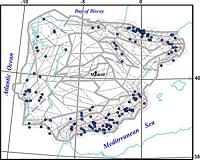| . |  |
. |
Madrid, Spain (SPX) Jun 28, 2010 Some areas of the Iberian Peninsula, where earthquakes of moderate magnitude have never yet been recorded, such as certain parts of the Cordillera Cantabrica mountain range, the far west of the Cordilleras Beticas mountains and the north of Valencia, could have the potential to generate such quakes, according to a study produced by Spanish, Russian and Italian scientists and published this month in the journal Rendiconti Lincei. "The methodology we have used confirms the most seismically significant areas of the Iberian Peninsula, but also identifies possible sources of earthquakes with magnitudes of over five in some areas where, to date, none have been recorded" Mariano Garcia-Fernandez, co-author of the study and a researcher at the Spanish National Museum of Natural Sciences (CSIC), tells SINC. According to the study, which has been published in the latest issue of the journal Rendiconti Lincei, these areas are located in some parts of the Cordillera Cantabrica mountain range, the northern coast of Portugal, the far west of the Cordilleras Beticas mountains and the north of Valencia. The remaining areas with the potential for moderate seismic activity are the same as those shown on seismic maps - around the edges of the Peninsula, above all the south east and the Pyrenees. "The important thing about this study is that it identifies zones prone to moderate earthquakes at regional level, although this does not mean they will ever happen", points out Garcia-Fernandez. The researcher explains that the magnitude 5 was chosen as the threshold for potential earthquakes "since it is above this level that you start to see significant damage to structures". In search of nodes The research, which is the fruit of collaboration between scientists at the Russian Academy of Sciences, the International Centre for Theoretical Physics and the University of Trieste (Italy) and the CSIC, is based on the morphostructural zoning method. The technique uses topographic, geological and geophysical information, along with satellite imagery, to identify the nodes or intersection points of morphostructural lines. These nodes are classified as likely to cause earthquakes of a specific threshold size by combining the seismicity data from seismic catalogues with mathematical recognition methods, similar to those used in voice or fingerprint identification. Garcia-Fernandez insists that the resulting classification does not necessarily mean that the potentially seismic nodes identified will produce earthquakes of this size, "but rather that their features make them more susceptible than those classified as having lower potential". The authors of the study are confident that the results will make it possible to better identify the continental seismogenic sources affecting the Iberian Peninsula. This will allow progress to be made in studies into danger levels and seismic risk at regional scale and in specific places, such as metropolitan areas or special structures such as nuclear power plants and large dams.
Share This Article With Planet Earth
Related Links FECYT - Spanish Foundation for Science and Technology Bringing Order To A World Of Disasters When the Earth Quakes A world of storm and tempest
 New Areas Prone To Moderate Earthquakes Identified In Iberian Peninsula
New Areas Prone To Moderate Earthquakes Identified In Iberian PeninsulaMadrid, Spain (SPX) Jun 25, 2010 Some areas of the Iberian Peninsula, where earthquakes of moderate magnitude have never yet been recorded, such as certain parts of the Cordillera Cantabrica mountain range, the far west of the Cordilleras Beticas mountains and the north of Valencia, could have the potential to generate such quakes, according to a study produced by Spanish, Russian and Italian scientists and published this month ... read more |
|
| The content herein, unless otherwise known to be public domain, are Copyright 1995-2010 - SpaceDaily. AFP and UPI Wire Stories are copyright Agence France-Presse and United Press International. ESA Portal Reports are copyright European Space Agency. All NASA sourced material is public domain. Additional copyrights may apply in whole or part to other bona fide parties. Advertising does not imply endorsement,agreement or approval of any opinions, statements or information provided by SpaceDaily on any Web page published or hosted by SpaceDaily. Privacy Statement |